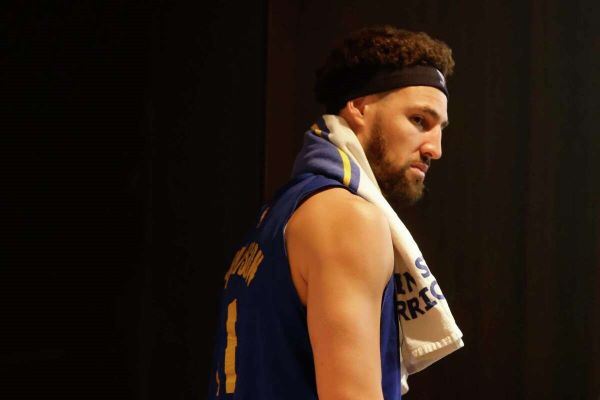Article Link:
‘Klay understands his body’: Thompson still working through
injury aftermath (sfchronicle.com)

After the
triumphant return from a 941-day hiatus, after the memorable playoff performances, after
the Champagne-popping at yet another championship parade,
Golden State Warriors guard
Klay Thompson struggled to do the comparably simple: play pickup basketball.
In authoring one of the greatest comeback stories in NBA history, he had
benefited from the team training staff’s supervision. This past
summer, as Thompson considered attending his first open run in more than
1½ years, his mind wandered to the
morning of Nov. 18, 2020: the pull-up jumper he attempted during a pickup game in Los Angeles;
the sharp pain he felt surge up his right heel; the immediate realization
he had torn his Achilles tendon.

“The last time I did play pickup without our training staff’s
supervision, it ended horribly,” Thompson told The Chronicle. “I
would just think about that. What if it happened again?”
Such fear is hardly uncommon for athletes
who’ve sustained severe injuries, but that doesn’t make it any less detrimental. Thompson’s
decision to not play pickup hurt his conditioning and compelled the Warriors
to hold him out almost all preseason. If he endures a rough start in the
regular season, it won’t take a basketball savant to guess the reason.
Perhaps the bigger takeaway, though, is that Thompson is still navigating
the aftermath of his prolonged absence. A slew of big games last season
— the nine 3-pointers in Atlanta, the 41 points in New Orleans,
the timely defense in the NBA Finals — might have lulled some into
thinking he was all better. But recovering from traumatic experiences
comes with unpredictable and often long-lasting repercussions.
Rick Celebrini — the Warriors’ director of sports medicine
and performance — recognizes as much, which is why he didn’t
push when Thompson told him he didn’t want to play pickup this past
offseason. Rushing the emotional healing process could prove far more
costly than Thompson missing some preseason games.
Dr. Vernon Williams — a sports neurologist at Cedars-Sinai Kerlan-Jobe
Institute in Los Angeles — said Thompson’s absence from summer
pickup runs fits what medical experts call “fear-avoidance”:
the hesitation to participate in activities steeped in trauma. In more
extreme cases, fear-avoidance can resemble mild forms of post-traumatic
stress disorder, with people suffering panic attacks at the mere thought
of a certain sensitive situation.
“I’ve seen people who had a significant injury in a motor-vehicle
accident say, ‘Hey, I don’t drive anymore,’” said
Williams, who consults for the Los Angeles Lakers and Rams. “Or,
‘I don’t drive on the freeway anymore because that accident
happened on the freeway.’
“They will take surface streets. It will take them twice as long
to get somewhere because they want to vigorously avoid that activity.”
How people cope with fear-avoidance depends on their case’s severity.
Some are content to stay away from specific activities for the rest of
their lives. But when that avoidance negatively affects someone’s
livelihood or relationships, Williams said, the issue must be addressed
through therapy, meditation, visualization or breathing exercises.
Long
a proponent of meditation, Thompson listens to nature sounds or classical music — Beethoven
and Mozart are two of his favorites — for roughly 30 minutes each
morning as he concentrates on each breath. It was his conscious decision
this past summer to not visualize himself in a pickup game. With Celebrini’s
approval, Thompson chose to spend his workouts focusing on individual
skill work.
For two to three hours, five days a week, he lifted weights, cycled through
drills and played his older brother, Mychel, in one-on-one. In doing so,
Thompson knew he likely would have to sit out at least part of the preseason.
There is no replacement for the kind of conditioning 5-on-5 scrimmaging offers.
“I stayed in shape this summer, but I just didn’t feel like
playing 5-on-5 without the training staff there,” Thompson said.
“They do a great job with their data analysis and gauging where
my body’s at under duress.
“So, for me, pickup just wasn’t the highest of importance.
I didn’t want to get ahead of myself. I know we have a championship
to win.”
By not scouring Los Angeles and the Bay Area for the best pickup runs,
Thompson afforded himself more time for hobbies: travel, reading, chess,
video games and, of course, boating. When training camp opened last month,
he felt as good mentally as he had in several years, he said.
To get in game shape, he would have to stay after practices and shootarounds
for 5-on-5 work with Mychel (
a video coordinator), other support staffers and seldom-used reserves. Subtle nuances —
his better reaction time, his improved speed into jumpers — make
Thompson believe he should have a chance at his first All-Star appearance
since 2019.
“Klay understands his body better than anyone,” Mychel said.
“When he told me he didn’t want to play pickup, I didn’t
question him. He’s proven he knows what he’s doing. He deserves
that benefit of the doubt.”
Though Thompson flashed his
old two-way dominance last season, he hadn’t been as consistent with his shot or perimeter
defense. This was to be expected in the wake of back-to-back major injuries
that sidelined him for more than 2½ years.
The Warriors’ training staff views Thompson’s lingering reluctance
to play pickup as just another part of his re-acclimation. When Golden
State hosts the Lakers on Tuesday night, he will don his No. 11 in an
opener for the first time in nearly 1,500 days.
To help prepare himself for that moment, Thompson has been thumbing to
YouTube on his iPhone. Each viewing of his best performances in last spring’s
playoffs made the memory of that Nov. 18, 2020, morning slightly less vivid.
“I’m sure I’ll play pickup next summer,” Thompson
said. “But right now, I’m just excited to experience an opening
night again. I get chills thinking about it.”